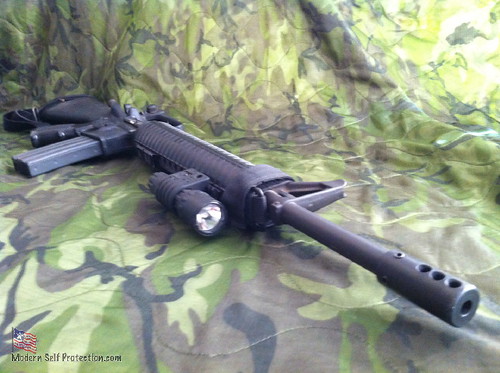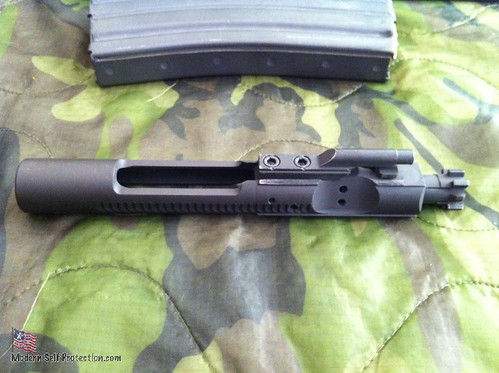
One of you guys out there asked about the AR, so here are the basics. First off, AR stands for Armalite, as in the company that originally employed Eugene Stoner as the chief engineer, and originally made the rifle. The rifle was originally the AR-10 chambered in 7.62 NATO designed for the American military market. It was submitted in 1956 to the Army’s Proving Ground. It was turned down in favor of the T44, later to become the M14 and then the M1A in the civilian market. Later, at the request of the military, the rifle was scaled down to chamber the .223 Remington and became the AR-15. Armalite sold the rights to Colt and the rifle became the M16.
The M16 had a bunch of corners cut at first to make it cheaper to produce. Then it was issued to troops without training. Also, the first batches of ammunition ordered were junk, so the rifle got a horrible reputation for reliability. Over the years, the weapon system has been upgraded and morphed and now there are a couple hundred companies and versions of the AR. So how does it work?
The AR is a direct gas impingement system. It uses the pressure from the bullet exiting the barrel to unlock the rotating bolt and cycle the weapon. What the heck does that mean? To keep the pressure safe until the bullet leaves the barrel, the bolt rotates and locks into the end of the barrel. The bolt face holds the round and allows the firing pin to pass through.

When the round is fired, the pressure builds up and pushes the bullet down the barrel. Towards the end of the barrel, underneath the front sight, is the gas block. The entire reason for the gas block is that there is a tiny pin sized hole in the top of the barrel that lines up with a tiny hole in the gas block. Coming out of the gas block is a tube (the gas tube). While the pressure is still high and the bullet is towards the end of the barrel, some of the gas escapes through the hole into the tube. The tube carries the gas back to the chamber. The gas tube is locked into the carrier key.

The carrier key sits on top of the bolt carrier (guess what the carrier does?). The bolt carrier holds the bolt and allows it to turn to lock and unlock. When the gas pushes against the key it pushes the carrier back. The motion of the carrier moving back turns the bolt to unlock it. By this time, the bullet is out of the barrel and the pressure has gone down substantially.

Now the rifle works kind of like any other semi automatic gun. The bolt and carrier continue to move back with the extractor holding onto the spent casing. The ejector is a spring-loaded pin on the bolt face. As soon as the bolt and carrier move back far enough for the case to clear the ejection port, the spring pops the case clear of the rifle.
As the carrier moves back, it is pushed against the buffer (a little piece of metal that is designed to help the carrier compress the buffer spring. The spring and buffer are in the stock to help keep the length of the rifle down and use extra space. The carrier actually moves back into the stock and compresses the spring. The spring pushes the carrier forward, strips a round from the magazine and pushes it into the chamber. The energy of the carrier slamming forward causes the bolt to be pushed into the locking lugs and rotate to lock. The carrier also cocks the hammer as it goes back and forth.
Newer AR’s are starting to use a piston system. Most are a “short” piston system. The name has nothing to do with the length of the piston, but the distance it moves. There are a lot of different systems and no standard yet. But the basic idea is that the gas tube is replaced by a piston that moves in a channel. The gas still escapes through the hole at the end of the barrel and into the gas block. The piston is sitting against the gas block so the pressure moves the piston. The piston pushes against the carrier, moving it back enough to unlock the bolt. From there the rifle functions like any other AR. The advantages of this are a cleaner and cooler system. The hot and dirty gas isn’t coming back into the action. That’s the entire advantage.
There are a couple good inventions on the system that I like. The first little bit is the ejection port cover. It covers the ejection port to keep dirt out of the action when not being fired. I think it’s a good design and is a hinged flap and spring loaded. It has a spring-loaded detent that holds it closed until the bolt moves. When the bolt moves, it bumps the detent on the top and the spring pushes it open. It stays open until you close it.
So this is just the start of how an AR works and how you can use it. I think the system is a great design and I have shot hundreds of thousands of rounds through one type or another over the years and really enjoy it as a target, competition, and fighting rifle. Next time, we’ll talk about operating the rifle.
Stay Safe,
Ben
| [AFG_gallery id=’3′] |
Thoughts on AR-15 (5.56) vs AR-10 (7.62)? I like and have used extensively in the military and civilian life the M-4/AR-15. But I’m thinking about “upgrading” to an AR-10 and was wondering about your opinion.
Thanks for the comment! I am a complete fan of the AR platform and like the way you think. I have 2 AR-15s and no AR-10s. I like the 5.56mm better because it’s generally cheaper, easier to get more ammo, lighter, and recoils less. The problem with the M4/AR-15 in combat is the choice of ammo. If you put a little better ammo in it, the stopping power goes up exponentially.
I would suggest you keep an all-around AR-15 and then if you want get an AR-10. The AR-10 will give you little advantage over an AR-15. The only real advantage is the bigger bullet it fires and that really increases your practical range. Also, it may be legal to hunt with when a .22 is not. Here in Texas I can hunt anything with my .223. I’m just not a huge fan of the AR-10 unless you want to shoot/hunt at longer ranges where the .308 will give you a real advantage. I’m not sure the weight and price are worth it.
The bottom line, is if you want one, and can afford it, get one. But, don’t sell your .223 to get one. I think you would miss it too much.
If you where buying your first rifle, I would say buy a .223 first and then if you want another one, buy a .308 version.